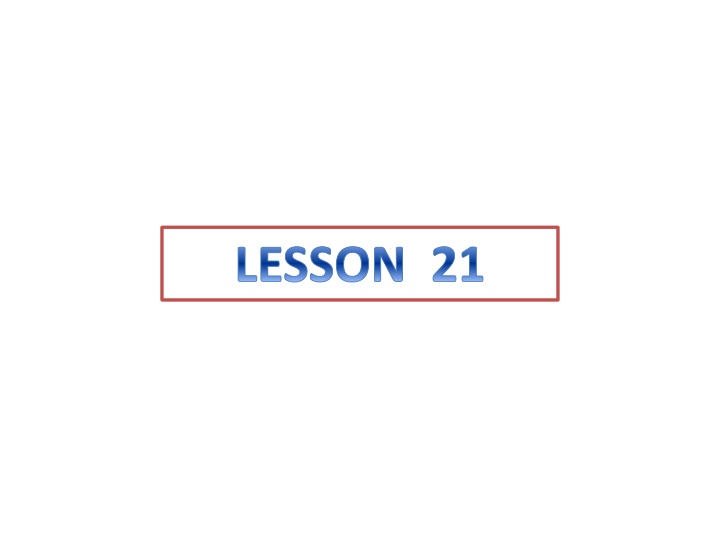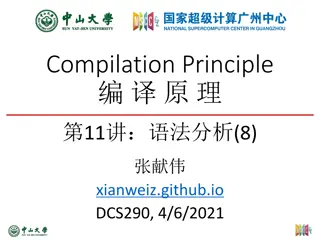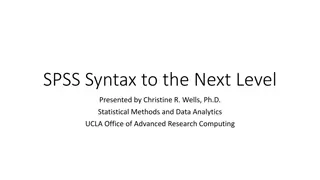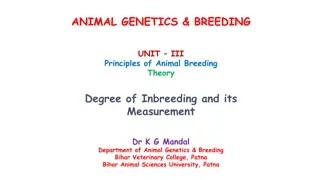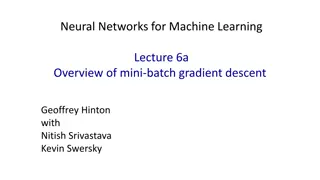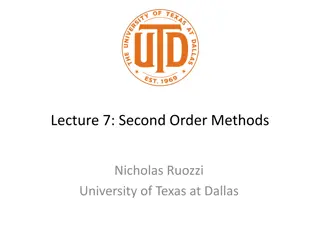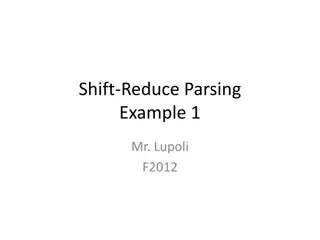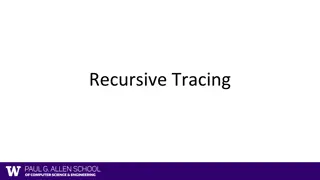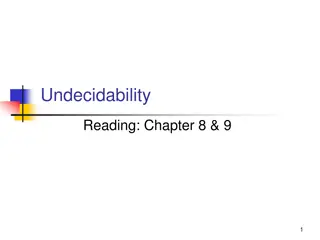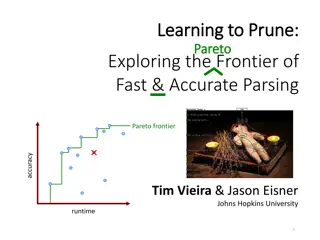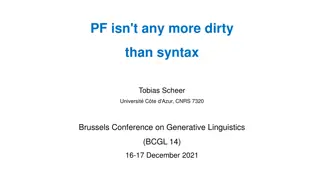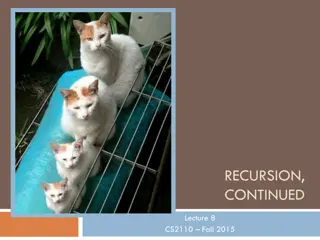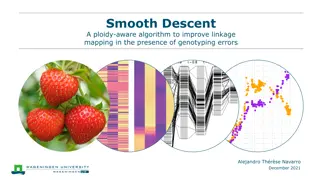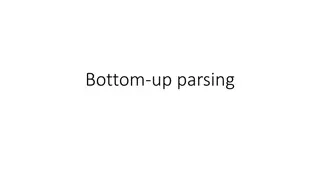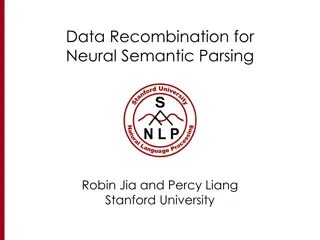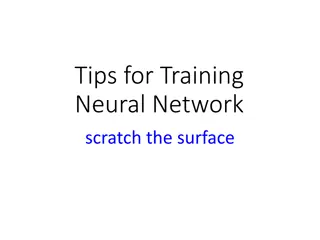Overview of Recursive Descent Parsing in Syntax Analysis
Recursive descent parsing is a top-down approach where the parser validates the input stream's syntax from left to right. The process involves matching characters with grammar terminals for correct syntax verification. This method enables parsers to look ahead, matching characters and advancing the input stream pointer accordingly.
Download Presentation

Please find below an Image/Link to download the presentation.
The content on the website is provided AS IS for your information and personal use only. It may not be sold, licensed, or shared on other websites without obtaining consent from the author.If you encounter any issues during the download, it is possible that the publisher has removed the file from their server.
You are allowed to download the files provided on this website for personal or commercial use, subject to the condition that they are used lawfully. All files are the property of their respective owners.
The content on the website is provided AS IS for your information and personal use only. It may not be sold, licensed, or shared on other websites without obtaining consent from the author.
E N D
Presentation Transcript
Overview of Previous Lesson(s)
Over View Recursive Descent Parsing It is a top-down process in which the parser attempts to verify that the syntax of the input stream is correct as it is read from left to right. A basic operation necessary for this involves reading characters from the input stream and matching then with terminals from the grammar that describes the syntax of the input. Recursive descent parsers will look ahead one character and advance the input stream reading pointer when proper matches occur. 3
Over View.. E T E E + T E | FIRST(E ) = {+, t} T F T FIRST(T ) = {*,t} T *FT | FOLLOW(E) = FOLLOW(E') = {), $} F (E) | id FOLLOW(T) = FOLLOW(T') = {+, ) , $} FOLLOW(F) = {+, *, ), $} FIRST(F) = FIRST(T) = FIRST(E) = { ( , id } 4
Over View A non recursive predictive parser can be built by maintaining a stack explicitly, rather than implicitly via recursive calls. If w is the input that has been matched so far, then the stack holds a sequence of grammar symbols such that 5
Over View Table-driven predictive parsing algorithm describes how configurations are manipulated 6
Over View Panic Mode Recovery Panic-mode error recovery is based on the idea of skipping symbols on the input until a token in a selected set of synchronizing tokens appears. Its effectiveness depends on the choice of synchronizing set. The sets should be chosen so that the parser recovers quickly from errors that are likely to occur in practice. 8
Over View Phrase-level Recovery Phrase-level error recovery is implemented by filling in the blank entries in the predictive parsing table with pointers to error routines. These routines may change, insert, or delete symbols on the input and issue appropriate error messages. They may also pop from the stack. Alteration of stack symbols or the pushing of new symbols onto the stack is questionable for several reasons. First, the steps carried out by the parser might then not correspond to the derivation of any word in the language at all. Second, we must ensure that there is no possibility of an infinite loop. 9
Over View Bottom-up parsing is the process of "reducing" a string w to the start symbol of the grammar. A sequence of reductions are shown. id * id, F * id, T * id, T * F, T, E By definition, a reduction is the reverse of a step in a derivation 10
Over View Formally if S * Aw then production A in the position following is a handle of Aw The string w to the right of the handle must contain only terminal symbols 11
Over View Shift-reduce parsing is a form of bottom-up parsing in which a stack holds grammar symbols and an input buffer holds the rest of the string to be parsed. Handle will always appears at the top of the stack just before it is identified as the handle We use $ to mark the bottom of the stack and also the right end of the input. Initially, the stack is empty and the string w is on the input 12
Contents Bottom-Up Parsing Reductions Handle Pruning Shift-Reduce Parsing Conflicts During Shift-Reduce Parsing Introduction to LR Parsing Why LR Parsers? Items and the LR(0) Automaton The LR-Parsing Algorithm Constructing SLR-Parsing Tables Viable Prefixes 14
Shift-Reduce Parsing.. During a left-to-right scan of the input string, the parser shifts zero or more input symbols onto the stack, until it is ready to reduce a string of grammar symbols on top of the stack. It then reduces to the head of the appropriate production. The parser repeats this cycle until it has detected an error or until the stack contains the start symbol and the input is empty: Upon entering this configuration, the parser halts and announces successful completion of parsing. 15
Shift-Reduce Parsing Configurations of a shift-reduce parser on input id1*id2 16
Shift-Reduce Parsing The primary operations are shift and reduce. But there are actually four possible actions a shift-reduce parser can make: shift, reduce, accept, and error 1. Shift the next input symbol onto the top of the stack. 2. Reduce The right end of the string to be reduced must be at the top of the stack. Locate the left end of the string within the stack and decide with what non-terminal to replace the string. 3. Accept Announce successful completion of parsing. 4. Error Discover a syntax error and call an error recovery routine. 17
Conflicts in Shift-Reduce Parsing There are grammars (non-LR) for which no viable algorithm can decide whether to shift or reduce when both are possible or which reduction to perform when several are possible. However, for most languages, choosing a good lexer yields an LR(k) language of tokens. Ex ada uses () for both function calls and array references. If the lexer returned id for both array names and procedure names then a reduce/reduce conflict would occur when the stack was ... id ( id and the input was ) ... 18
Conflicts in Shift-Reduce Parsing Since the id on TOS should be reduced to parameter if the first id was a procedure name and to expr if the first id was an array name. A better lexer would return proc-id when it encounters a lexeme corresponding to a procedure name. It does this by consulting tables that it builds. 19
LR Parsing LR(k) parsing L is for left-to-right scanning of the input. R is for constructing a rightmost derivation in reverse. (k) represents the number of input symbols of look-ahead that are used in making parsing decisions. When (k) is omitted, k is assumed to be 1 20
Why LR Parsers Most commercial compilers use hand-written top-down parsers of the recursive-descent (LL not LR) variety. Since the grammars for these languages are not LL(1), the straightforward application of the techniques we have seen will not work. Instead the parsers actually look ahead further than one token, but only at those few places where the grammar is in fact not LL(1). 21
Why LR Parsers.. Compiler writers claim that they are able to produce much better error messages than can readily be obtained by going to LR. Error messages is a very important user interface issue and that with recursive descent one can augment the procedure for a non-terminal with statements like if (nextToken == X) then error(expected Y here) LR parsers are table-driven, much like the non-recursive LL parsers. A grammar for which we can construct a parsing table is said to be an LR grammar. 22
Why LR Parsers.. Intuitively, for a grammar to be LR it is sufficient that a left-to-right shift-reduce parser be able to recognize handles of right-sentential forms when they appear on top of the stack. LR parsing is attractive for a variety of reasons: LR parsers can be constructed to recognize virtually all programming language constructs for which context-free grammars can be written. The LR-parsing method is the most general non-backtracking shift- reduce parsing method known, yet it can be implemented as efficiently as other, more primitive shift-reduce methods 23
Why LR Parsers.. An LR parser can detect a syntactic error as soon as it is possible to do so on a left-to-right scan of the input. The class of grammars that can be parsed using LR methods is a proper superset of the class of grammars that can be parsed with predictive or LL methods. The principal drawback of the LR method is that it is too much work to construct an LR parser by hand for a typical programming- language grammar. 24
Items & LR(0) Automaton An LR parser makes shift-reduce decisions by maintaining states to keep track of where we are in a parse. States represent sets of "items." An LR(0) item of a grammar G is a production of G with a dot at some position of the body. Thus, production A XYZ yields the four items A XYZ A X YZ A XY Z A XYZ 25
Items & LR(0) Automaton.. One collection of sets of LR(0) items, called the canonical LR(0) collection provides the basis for constructing a deterministic finite automaton that is used to make parsing decisions known as LR(0) automaton. The automaton for the expression grammar is shown in next slide and will serve as the running example for discussing the canonical LR( 0) collection for a grammar. E E + T | T T T * F | F F ( E ) | id 26
Items & LR(0) Automaton... To construct the canonical LR(0) collection for a grammar, we define an augmented grammar and two functions, CLOSURE and GOTO If G is a grammar with start symbol S, then G', the augmented grammar for G, is G with a new start symbol S' and production S' S The purpose of this new starting production is to indicate to the parser when it should stop parsing and announce acceptance of the input. That is, acceptance occurs when the parser is about to reduce by S' S 28
Items & LR(0) Automaton... Closure of Item Sets If I is a set of items for a grammar G, then CLOSURE(I) is the set of items constructed from I by the two rules: Initially, add every item in I to CLOSURE(I) If A B is in CLOSURE(I) and B is a production, then add the item B . to CLOSURE(I)if it is not already there. Apply this rule until no more new items can be added to CLOSURE(I) 29
Items & LR(0) Automaton... Ex. Augmented Grammar E E E E + T | T T T * F | F F ( E ) | id If I is the set of one item { [E ' E] } , then CLOSURE(I) contains the set of items I0 E E E E + T | T T T * F | F F (E) | id 30
Items & LR(0) Automaton... It is pertinent to mention that if one B-production is added to the closure of I with the dot at the left end, then all B-productions will be similarly added to the closure. We divide all the sets of items of interest into two classes: Kernel items: The initial item, S S and all items whose dots are not at the left end. Non-kernel items: All items with their dots at the left end, except for S S 31
Items & LR(0) Automaton... The Function GOTO The second useful function is GOTO(I,X) where I is a set of items & X is a grammar symbol. GOTO(I,X) is defined to be the closure of the set of all items [A X ] such that [A X ] is in I Intuitively, the GOTO function is used to define the transitions in the LR(0) automaton for a grammar. The states of the automaton correspond to sets of items, & GOTO(I,X)specifies the transition from the state for I under input X 32
Items & LR(0) Automaton... Ex. Augmented Grammar E E E E + T | T T T * F | F F ( E ) | id If I is the set of two item { [E ' E], [E E + T] } , then GOTO(I,+) contains the items E E + T T T * F | F F (E) | id 33
Items & LR(0) Automaton... Algorithm to construct C, the canonical collection of sets of LR(0) items for an augmented grammar G 34
